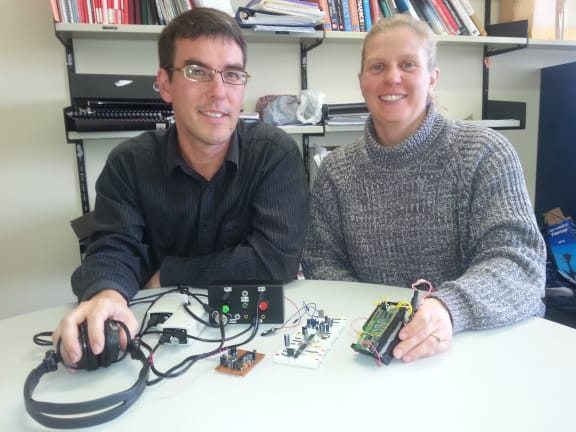Like a torch, a device developed by Auckland researchers can illuminate the surrounding environment.
But instead of using light, this device uses sound.
Specifically, it uses ultrasound.
“A signal is sent out at ultrasound, through a transmitter that the person can hold in their hand. Reflections from the environment come back to the individual and can be picked up with receivers,” says Claire Davies, a senior lecturer at the University of Auckland. “Those receivers can actually convert the sound into an audible range signal, so users can actually hear the obstacles around them.”

Shane Pinder (left) and Claire Davies with some protoypes of the echolocation device Photo: RNZ / R. Beran
It’s very similar to echolocation, a system used by animals like dolphins and bats, where they navigate by making clicks to hear sound reflecting off objects.
In this electronic device, the Doppler effect is used to translate relative movement between the user and a reflected obstacle into sound.
“It literally makes your surroundings sound as though they’re all making noise, but only if they’re moving relative to you,” says Shane Pinder from Defiant Engineering, the co-inventor of the device.
The device is designed for visually-impaired people who may use a cane or a guide dog, but would like additional information about objects that are above waist height.
“The sound that is emitted by this is at a frequency higher than that which guide dogs can hear. So we never find that we have any problems in an environment where a guide dog is used,” says Claire.
Ruth Beran got to trial an early prototype, and could hear the whooshing sound made by moving objects in the environment.
“The faster it’s moving, the higher the frequency -- the higher the pitch of the sound that it’s making. The closer it is to you, or the larger it is, the louder it is,” says Shane.
Ultimately, the goal is to make a device about the size of a 9 volt battery or a hand held mp3 player with a transmitter at the end, and earbuds which have ultrasonic microphones embedded on the outside to enable the sound to come into the ears.
Another aim is that the ambient sound would also come through the headphones, with the sound of the device superimposed on that.
“The idea is that it acts as a background noise or an ambient noise behind the person so it doesn’t interfere with other senses that they’re trying to listen to and so they are able to hear other obstacles in their environment,” says Claire.
And since the device uses sound, it can work just as well in the dark as it can in the light.
“We’re constantly looking for other ways that this might be useful to people, not just people who are visually-impaired,” says Shane.
So someone using a standard mp3 player or smart phone in the future, may be able to navigate in the dark using ultrasound, without the need to turn on a torch.

